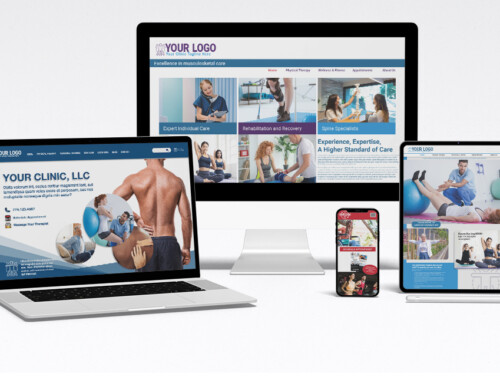Simple Principles Help Make Your Physical Therapy and Health Care Website The Hub Of A Patient-Generating Marketing System, Not Just An Online Business Card
Website and internet management decisions grow more and more important for physical therapy and health care practitioners every day. Gone are the days when a provider could get by with a cheap $39 a month website, a picture or two, contact information, and an About Us page. Instead, websites have become the hub for strategic “want or need to know” information about your marketplace that drives consumer choice and influences referral patterns.
Yet while the push to the internet accelerates, we still see large numbers of providers struggle, postpone, and bungle even the most basic website decisions. Why? Perhaps the simple answer is confusion over what to expect from the website and how to sort out all the choices. Once you know what to expect, you can place a value on the site based on the potential impact on your business. With a sense of value in mind the job of sorting out your options should be straightforward.
What To Expect From Your Website – From The Marketplace To The Backend
In The Marketplace
Think of your website in the marketplace in two categories: Services and Referral Generation.
Services
Your website should provide services that improve the customer experience and ease of doing business. Don’t narrow your thinking about functionality to just “branding” or displaying basic service and contact information. Obviously, the low cost, high speed, large informational-transactional capacity, and extensive reach of the internet make it ideal for virtually all a practitioner’s business functions with the exception of delivering physical goods and services.
As the use of most computing and internet technologies continue to converge on mobile devices, the delivery of all “soft” products and services will converge as well. Patient intake forms, scheduling, appointment reminders, and online payments through mobile devices are all simple examples. Start with the simple basics like online appointment forms, and get your business services online now, don’t wait.
Referral Generation
Referral generation flows from great content. Great content is a traffic generator: Search engines are smart enough to find and rank it, and visitors are engaged enough to stick on your site rather than bounce around exploring other search results.
Great content facilitates the visitor’s decision making process by providing information about diagnosis and treatment options, and then helping them understand how to choose the best provider. Each visitor wants the best care available, not the second best, and usually has no idea how to find it or even what to ask. Good strategic content avoids self-serving platitudes like “most experience” and “caring about you.” Instead, it provides checklists, reports, and other offers for more information that educates the visitor to a point where they draw the conclusion you are the best choice. And, if they can “click here” to chat now, register for an event, refer a friend, request a complimentary consultation, or request an appointment – just the basics, but that’s a GOOD start for an engaging site.
The Back End
Planning & Design
Ninety-nine out of one-hundred people reading this article should not expect (or even attempt) to build, maintain, host, or manage their internet presence themselves. Despite the TV commercials promoting “click-click” and you are done, this is a really bad idea. Most likely, the site will not meet your needs, and you will pull your hair out trying to keep up with the call to maintain it, or worse yet, not be able to publish it without many important pages missing, “under construction,” or just looking awful. Yes, great website building tools exist, but you still need extensive training, expertise, and LOTS of time to work with them.
That being said, even though you shouldn’t be producing your site, you do need to understand enough about the platform choices so you know what to expect for support, development, and maintenance. Avoid proprietary technologies where the website can’t be purchased and moved should you need to do so. To protect your investment, choose a widely supported open source platform with a large community of independent developers who can step in at any time.
Strategic Content
Understand that there is a big difference between the website design and the CONTENT. The most common mistake you can make is to go for a website designer who also masquerades as a content provider. Anyone can post a welcome message, pictures, and other basic information, but the battle is won with good strategic content (yes, this is a competitive battle). A pretty design will not overcome the internet demand and the visitor’s appetite for relevant content.
Don’t be intimidated: Many small practice managers look at what their larger competitors are doing on the web and draw the conclusion they can’t afford to compete. If that’s you, here’s the good news – most of the online applications you will need are readily available and affordable. If you can’t afford or don’t want to lay out the cash to purchase a system, consider licensing with an option to buy. Make sure you partner with a strategic web content provider who not only has a track record for generating and qualifying patient leads in your field, but also integrates the concepts into your offline materials as well.








Leave A Comment
You must be logged in to post a comment.